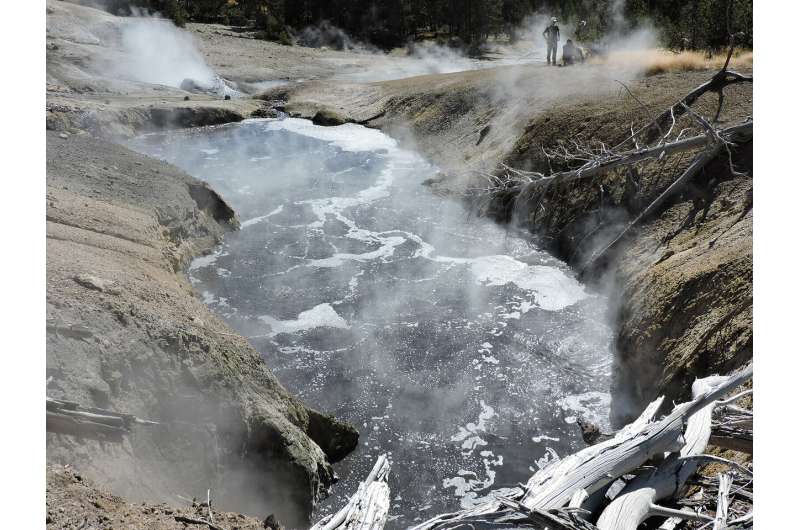The expanding universe of methane metabolisms in archaea

Methane is a greenhouse gas 20 times more potent than carbon dioxide. Billions of years ago, methane-producing archaea likely played a key role in determining the composition of the Earth's atmosphere and regulating the global climate for life to flourish.
For Guillaume Borrel and Simonetta Gribaldo of the Institut Pasteur in France, the importance of methanogenesis and the presence of methanogens in nearly all types of anaerobic environments suggest the diversity of methane metabolisms is "vastly underestimated." In the March 4, 2019, issue of Nature Microbiology, they mined the JGI's Integrated Microbial Genomes & Microbiomes (IMG/M) database maintained by the U.S. Department of Energy (DOE) Joint Genome Institute (JGI), a DOE Office of Science User Facility, for publicly available metagenome data provided by the other study co-authors, and reconstructed from these 10 metagenome-assembled genomes (MAGs) representing new potential methanogenic, anaerobic methanotrophic and short-chain alkane-oxidizing archaea. They used IMG because the database already contains metagenome datasets from a variety of environments, as well as tools for analysis.
"There is evidence that methanogenesis is one of the oldest metabolisms, with the first traces possibly at ~3.5 Gy (billion years)," Borrel and Gribaldo said in an email. "Therefore, determining under which form it emerged and how it gave rise to the different pathways we see today is not only important to understand early life, but also to link the evolution of this metabolism to geochemical data, which in turn can help to understand its impact on climate along earth history."
Marker genes for diverse methane metabolisms
Of the 10 MAGs reconstructed in the study, five were from undersampled or previously undescribed lineages, and the other five only distantly related to known methanogens. With the help of this information, the researchers found evolutionary relationships between methanogenesis, methanotrophy, and short-chain alkane oxidation metabolisms. They also identified a set of 38 marker genes that serve as a core set of genes present in archaea with metabolisms involving methyl-coenzyme M reductase (MCR), the final step in methanogenesis, or MCR-like complexes, likely involved in short-chain alkane oxidation.
"We propose a scenario where methanogenesis is possibly the most ancient energetic metabolism in the Archaea, and was lost many times independently during archaeal evolution or evolved into methanotrophy and short-chain alkane oxidation," Borrel and Gribaldo said. "Overall, these results show a striking case of how metabolic diversity can emerge from tinkering of a common set of enzymes."
Gribaldo will be speaking on "Exploration of Metagenomic Data to Understand the Diversity and Evolution of Methane Metabolisms" at the NeLLi: New Lineages of Life Symposium in April, which immediately precedes the JGI's 14th Annual Genomics of Energy & Environment Meeting. Registration for both the NeLLi Symposium and for the JGI Annual Meeting closes on March 11, 2019.

Novel Yellowstone archaeon belongs to Korarchaeota
Drs. Luke McKay and William Inskeep are co-authors on the Borrel et al. study described above, and also led a separate study that is published in the same issue of Nature Microbiology. Their study focuses on the discovery of new populations within the Korarchaeota, one of which contains genes for both sulfur and methane metabolism.
The newly described Korarchaeota were identified in thermal sediments from Washburn Hot Springs in Yellowstone National Park. This large geothermal pool contains high levels of sulfur, methane, carbon dioxide and hydrogen. Inskeep, a longtime JGI collaborator at Montana State University, commented that "Washburn Hot Springs is a highly-reduced, suboxic system that may be analogous to environments found on early Earth."
Through the JGI Community Science Program, Inskeep and McKay recovered metagenome-assembled genomes from sediments sampled in Washburn Hot Springs and identified them as belonging to the Korarchaeota phylum. The finding tripled the known number of Korarchaeota genomes, which helped the researchers position the lineage within the archaeal domain. The information, Inskeep added, could also help in the search for a last common ancestor between Archaea and Eukarya.
One genome, two metabolic pathways
"Up to this point, most phylogenomic trees have relied on only one korarchaeotal representative," said first author McKay. "Now we're adding two more: one (Candidatus Korarchaeum cryptofilum WS) is similar to the known genome, and the other (Ca. Methanodesulfokores washburnensis) is more distantly related, containing genes for both methane and sulfur metabolisms." Methanogenesis and sulfur reduction are among the oldest mechanisms of energy conservation, but the genes for both pathways had never been observed in a single microbial population until now.
Ca. M. washburnensis was one of the most abundant populations detected in the Washburn sediments and based on metabolic reconstructions, the team has two main hypotheses: the novel korarchaeon could switch between methanogenesis and sulfite reduction depending on environmental conditions, or it could couple the two metabolisms by using sulfite to oxidize methane and hydrogen. McKay emphasized that "the latter possibility would represent a novel pathway for the anaerobic oxidation of methane, a subject of great interest in environmental and evolutionary microbiology."
Inskeep will be presenting a poster pitch at the upcoming NeLLi Symposium, discussing the "Distribution of predominant high-temperature archaeal and bacterial lineages in Yellowstone National Park," as well as details of the newly described members of the Korarchaeota.
More information: Guillaume Borrel et al. Wide diversity of methane and short-chain alkane metabolisms in uncultured archaea, Nature Microbiology (2019). DOI: 10.1038/s41564-019-0363-3
Luke J. McKay et al. Co-occurring genomic capacity for anaerobic methane and dissimilatory sulfur metabolisms discovered in the Korarchaeota, Nature Microbiology (2019). DOI: 10.1038/s41564-019-0362-4
Nature Microbiology "Behind the Paper": McKay, L. Methane and sulfur metabolisms collide in the Korarchaeota. naturemicrobiologycommunity.na … -in-the-korarchaeota
Journal information: Nature Microbiology
Provided by DOE/Joint Genome Institute



















